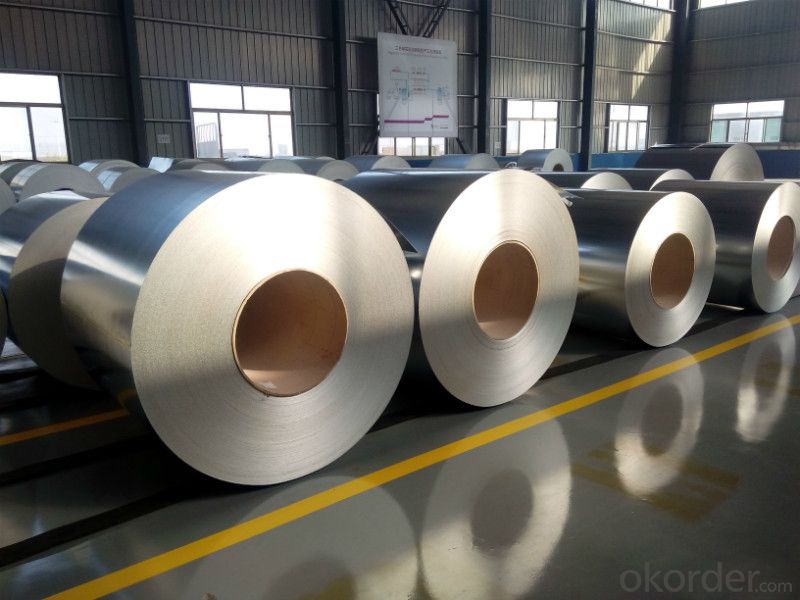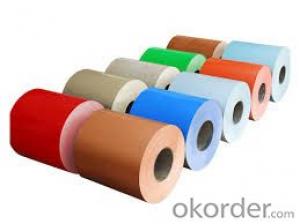Hot Rolled&Cold Rolled Galvanized Steel Coil
- Loading Port:
- China main port
- Payment Terms:
- TT OR LC
- Min Order Qty:
- 23 m.t.
- Supply Capability:
- 50000 m.t./month
OKorder Service Pledge
OKorder Financial Service
You Might Also Like
Item specifice
Product Description
Thickness: 0.16mm-1.20mm
Coil width:600mm-1250mm
Coil weight: 3.0-6.0MT
Surface finish : 60-120g/m2 zinc coating and any Ral code the customers requirment!
Spangle: Big Spangle,Small Spangle,Regular Spangle,Zero Spangle.
Steel grades: Q195-Q345,GR.A,GR.B, SPCC,SPHC,DX51D, ECT.
Standard: JIS G3302, JIS G3313, ASTM A653, GB/T2518-88, GB11253-89,ASTM A1008-2000,BS,ETC.
Packing: wrapped by plastic film and waterproof paper, and then fastened on wooden pallet.
Used in building material field,Pipe making, furniture making,others
Minimum order quantity : 25 tons
Delivery times : 20 days after received T/T or L/C
Payment terms : T/T or L/C ( or as your demand)
Supply abilty : 6,000 ton per month
Product Picture:


FAQ:
Size | (0.13mm-5.0mm )*(600mm-1500mm)*coil |
Steel Grade | JIS G3302 SGCC~SGC570,SGCH(FULL HARD-G550),SGHC~SGH540 EN 10346-DX51D+Z,DX53D+Z, S250GD~S550GD ASTM A653M CS-B, SS255~SS550 |
Coil Weight | 3MT-14MT |
Coil ID | 508mm/610mm |
Chemical Treatment | Chromated(Cr 3+,6+,0+) |
Surface | Skin pass/non skin pass |
Oil | Slight Oiled/Dry |
Spangle | Regular/Zero/Big |
Zinc Coating | Z40-Z300 |
Capacity | 1,500,000MT/year |
- Q:I have a knife with 154cm steel on it and I always here that you should put oil on it to keep it from rusting but I am just wondering what kind of oil? And how do I apply it and do I just leave it on there?
- There are several grades of steel and other types of metals used in knives. Like another user said, if it is something like 420 Stainless Steel (a very common knife steel grade), then you should not have to worry about it rusting. I still apply oil to my stainless steel knives though to keep the action smooth. Non-stainless will require oil to prevent rust if you are planning on using them heavily. There is a such thing as knife oil and you can find it online. A lot of car or sportting lubricants will work though. I use Rem Oil, a popular gun oil that you can find at Wally World for about $3 a can. Disassemble your knife. Use a solvent and a cleaning solution to clean off the old oil, dirt, and gunk. I use Hoppes solvent (a solvent that can be found at Wal-Mart for a few bucks) and either pour it into a small shot-glass and dip a toothbrush in it, dampen a wash-rag with it, or pour some in the cap and dab a cotton swab on it. Using one of these tools, I swab down my knives completely, focusing mainly on moving parts and parts of the knife that experiences high abrasion (the lock of a liner lock knife for example). Then I spray it down with Rem Oil. Reassemble the knife and let it sit overnight. The next day, I'll rub off any excess oil from the grips. Usually though, the knife is ready to rock the moment I reassemble it. So that's cleaning knives in a nutshell: take it apart, clean off the old oil and dirt, re-oil it with gun oil, then put it back together.
- Q:i mean cor ten steel( rusted)
- If the steel is true Cor Ten steel, it does not require waxing. Cor Ten is a steel designed to rust slowly over time ... then the rust acts as a natural barrier to prevent further rust. Check out the United States Steel building in downtown Pittsburgh, PA ... its nickname is The Rusty Nail.
- Q:This question is directed to anyone who has played or know someone who plays a lap or pedal steel guitar.I've been a guitarist for about 8 years now and have played a variety of styles from rock, fingerstyle/classical, singer/songwriter acoustic stuff, ect, and now I've really had an interest in learning how to play a lap steel or pedal steel guitar. I am completely new to the instrument(s), so I'm seeking all the information I can. I do know that a pedal steel is a lot more expensive, so I'm probably looking to start on a lap steel for now. Basically how should I get started? Should I find a cheap lap steel at a pawn shop or purchase something new? Are there any good method books out there? I'm a pretty experienced guitarist, so should I expect to get the hang of it quickly? Is there much of a market for a lap/pedal steel player? haha.Also, I am left handed. How much trouble would it be to re-string a steel guitar? Or would I be better off getting a left-handed model?
- Hello okorder / I'm not familiar with the brand...it's certainly not commonly played....but it has the features you need for a starter guitar.
- Q:What are the current trends in the steel coil industry?
- Some current trends in the steel coil industry include a growing demand for high-strength and lightweight steel coils, increased focus on sustainability and recyclability, advancements in technology for improved efficiency and productivity, and a shift towards automation and digitalization in manufacturing processes. Additionally, there is a rising preference for customized steel coil solutions to meet specific industry requirements.
- Q:What are the advantages of using steel coils?
- There are several advantages of using steel coils. Firstly, steel coils are highly durable and can withstand extreme conditions, making them suitable for various applications. Secondly, they provide excellent strength and stability, making them ideal for structural purposes. Additionally, steel coils can be easily molded into different shapes, allowing for customization and versatility in design. Moreover, steel coils have a high recycling rate, making them an environmentally friendly choice. Finally, steel coils offer cost-effectiveness due to their long lifespan and low maintenance requirements.
- Q:So I'm looking for some decently priced black motorcycle boots that have steel toes (and any additional protection) and look good in jeans. Pretty simple. Any recommendations?
- You don't need steel toes in a motorcycle. The top of the foot isn't where the danger comes from when injured in a motorcycle accident. Where you need the most protection is in the ankle and heel. The ankle twists and the heel and calf bang on the ground. You need some protection at the toes, but that is from the road impacting the toes and grinding against the boots as you slide. Any boots made for motorcyclists will do. Stay away from steel toed work boots - they are designed for a job site, not a motorcycle crash.
- Q:How are steel coils coated?
- Steel coils are coated through a process called coil coating, where the steel is cleaned, treated, and then coated with a protective layer using techniques such as roll coating or spray coating.
- Q:How do steel coils contribute to the strength and durability of structures?
- Steel coils contribute to the strength and durability of structures by providing a high tensile strength and resistance to deformation. When used in construction, steel coils can be formed into various shapes and sizes to reinforce structural components like beams, columns, and foundations. This reinforcement enhances the structural integrity, preventing the structure from collapsing under heavy loads or adverse conditions. Additionally, steel coils have excellent corrosion resistance, which ensures that the structure remains durable and long-lasting, even in harsh environments.
- Q:How are steel coils processed for specific applications?
- Steel coils are processed for specific applications through a series of carefully planned steps. The process begins with the selection of the appropriate grade and thickness of steel, which is determined based on the requirements of the end application. Once the steel coils are received, they undergo a series of processing steps to transform them into the desired product. The first step in processing steel coils is known as uncoiling, where the coil is unwound and straightened. This ensures that the coil is flat and ready for further processing. The uncoiled steel is then cleaned to remove any dirt, oil, or rust that may be present on the surface. This is typically done through a process called pickling, which involves immersing the steel in a bath of acid to remove any impurities. After cleaning, the steel undergoes various shaping processes depending on the desired application. This can include processes such as slitting, where the coil is cut into narrower strips, or shearing, where it is cut into specific lengths. These shaping processes are often performed using specialized machinery that can handle the high strength and thickness of steel. Once the steel has been shaped, it may undergo additional processes to enhance its properties. For example, it may be heat treated to increase its strength or hardness, or it may undergo a coating process to improve its corrosion resistance. Coating processes can include techniques such as galvanizing, where the steel is coated with a layer of zinc, or painting, where it is coated with a layer of paint. Finally, the processed steel coils are inspected for quality and undergo any necessary finishing processes. This can include processes such as trimming the edges to remove any irregularities, or applying protective coatings to prevent damage during transportation or storage. Overall, the processing of steel coils for specific applications is a complex and carefully controlled process. It involves a combination of shaping, cleaning, coating, and finishing processes to ensure that the steel meets the required specifications and is ready for use in various industries such as automotive, construction, and manufacturing.
- Q:How are steel coils processed for edge trimming or slitting during processing?
- Steel coils are processed for edge trimming or slitting during processing by using specialized machinery. The coils are uncoiled and fed through a slitting machine, which cuts the coil into narrower strips. These strips are then passed through an edge trimming machine, which removes any irregularities or excess material from the edges. This process helps to ensure that the steel coils meet the desired specifications and are ready for further processing or use in various industries.
1. Manufacturer Overview |
|
|---|---|
| Location | |
| Year Established | |
| Annual Output Value | |
| Main Markets | |
| Company Certifications | |
2. Manufacturer Certificates |
|
|---|---|
| a) Certification Name | |
| Range | |
| Reference | |
| Validity Period | |
3. Manufacturer Capability |
|
|---|---|
| a)Trade Capacity | |
| Nearest Port | |
| Export Percentage | |
| No.of Employees in Trade Department | |
| Language Spoken: | |
| b)Factory Information | |
| Factory Size: | |
| No. of Production Lines | |
| Contract Manufacturing | |
| Product Price Range | |
Send your message to us
Hot Rolled&Cold Rolled Galvanized Steel Coil
- Loading Port:
- China main port
- Payment Terms:
- TT OR LC
- Min Order Qty:
- 23 m.t.
- Supply Capability:
- 50000 m.t./month
OKorder Service Pledge
OKorder Financial Service
Similar products
New products
Hot products
Hot Searches
Related keywords



























